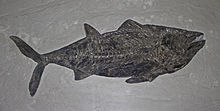A | B | C | D | E | F | G | H | CH | I | J | K | L | M | N | O | P | Q | R | S | T | U | V | W | X | Y | Z | 0 | 1 | 2 | 3 | 4 | 5 | 6 | 7 | 8 | 9
| True tunas | |
|---|---|

| |
| Yellowfin tuna | |
| Scientific classification | |
| Domain: | Eukaryota |
| Kingdom: | Animalia |
| Phylum: | Chordata |
| Class: | Actinopterygii |
| Order: | Scombriformes |
| Family: | Scombridae |
| Tribe: | Thunnini |
| Genus: | Thunnus South, 1845 |
| Type species | |
| Scomber thynnus Linnaeus, 1758
| |
| Subgenus | |
| |
| Synonyms | |
| |
Thunnus is a genus of ocean-dwelling, ray-finned bony fish from the mackerel family, Scombridae. More specifically, Thunnus is one of five genera which make up the tribe Thunnini – a tribe that is collectively known as the tunas. Also called the true tunas or real tunas, Thunnus consists of eight species of tuna (more than half of the overall tribe), divided into two subgenera.
Their coloring, metallic blue on top and shimmering silver-white on the bottom, helps camouflage them from above and below. Atlantic bluefin tuna, the largest member of this genus, can grow to 15 feet (4.6 m) long and weigh up to 1,500 pounds (680 kg). All tunas are extremely strong, muscular swimmers, and the yellowfin tuna is known to reach speeds of up to 50 miles per hour (80 km/h) when pursuing prey. As with all tunas, members of this genus are warm-blooded, which is a rare trait among fish; this enables them to tolerate cold waters and to dive to deeper depths.[3] Bluefin tunas, for example, are found in Newfoundland and Iceland, and also in the tropical waters of the Gulf of Mexico and the Mediterranean Sea, where some individuals go each year to spawn.
Due to overfishing, the range of this genus has declined significantly, having been effectively extirpated from the Black Sea, for example.[4]
Taxonomy
The word Thunnus is the Middle Latin form of the Greek thýnnos (θύννος, "tuna, tunny") – which is in turn derived from thynō (θύνω, "to rush; to dart").[5][6] The first written use of the word was by Homer.[citation needed]
Based on morphology and short-length mitochondrial DNA sequence data,[7] the genus Thunnus is currently classified into two subgenera: Thunnus (Thunnus) (the bluefin group), and Thunnus (Neothunnus) (the yellowfin group). However this classification has been questioned by a recent phylogenetic analysis of nuclear DNA sequence data, which resolved different relationships among species and did not support the traditional definition of the bluefin and yellowfin groups.[8][9] Specifically, these analyses substantiated the division of Pacific and Atlantic Tuna in two separate species and suggested that Bigeye Tuna were actually a member of subgenus Neothunnus, not subgenus Thunnus.[8] Earlier nuclear ribosomal DNA phylogenetic reconstructions also showed similar results.[10]

This genus has eight species in two subgenera:
- Subgenus Thunnus (Thunnus):
- Albacore, T. alalunga (Bonnaterre, 1788)
- Southern bluefin tuna, T. maccoyii (Castelnau, 1872)
- Bigeye tuna, T. obesus (Lowe, 1839)
- Pacific bluefin tuna, T. orientalis (Temminck & Schlegel, 1844)
- Atlantic bluefin tuna, T. thynnus (Linnaeus, 1758)
- Subgenus Thunnus (Neothunnus):
- Yellowfin tuna, T. albacares (Bonnaterre, 1788)
- Blackfin tuna, T. atlanticus (Lesson, 1831)
- Longtail tuna, T. tonggol (Bleeker, 1851)

| The True Tunas of the genus Thunnus, within the Family Scombridae | |||||||||||||||||||||||||||||||||||||||||||||||||||||||||||||||||||||
| |||||||||||||||||||||||||||||||||||||||||||||||||||||||||||||||||||||
| Cladogram: Thunnus (bottom-right in image above) is one of five genera that make up the Thunnini tribe. Known as the true tunas, it comprises 8 of the 15 extant tuna species.[1] |
| Alternative evolutionary tree for Thunnus |
| An alternative phylogenetic reconstruction for the genus Thunnus, based on nuclear DNA sequence data, which modifies the traditionally recognized bluefin and yellowfin clades by placing Thunnus obesus within the yellowfin clade instead of in the bluefin clade.[8] |
Species
Until recently, seven Thunnus species were thought to exist, and Atlantic bluefin tuna and Pacific bluefin tuna were subspecies of a single species. In 1999, Collette established that based on both molecular and morphological considerations, they are, in fact, distinct species.[11][12]
Thunnus, the true tunas Image Common name Scientific name Maximum
lengthCommon
lengthMaximum
weightMaximum
ageTrophic
levelSource IUCN status Thunnus (Thunnus) – the bluefin group 
Albacore tuna T. alalunga
(Bonnaterre, 1788)1.4 m
(4.6 ft)1.0 m
(3.3 ft)60.3 kg
(133 lb)9–13 yrs 4.31 [13][14] Zdroj:https://en.wikipedia.org?pojem=True_tuna
>Text je dostupný pod licencí Creative Commons Uveďte autora – Zachovejte licenci, případně za dalších podmínek. Podrobnosti naleznete na stránce Podmínky užití.
čítajte viac o True_tuna
Text je dostupný za podmienok Creative Commons Attribution/Share-Alike License 3.0 Unported; prípadne za ďalších podmienok.
Podrobnejšie informácie nájdete na stránke Podmienky použitia.


